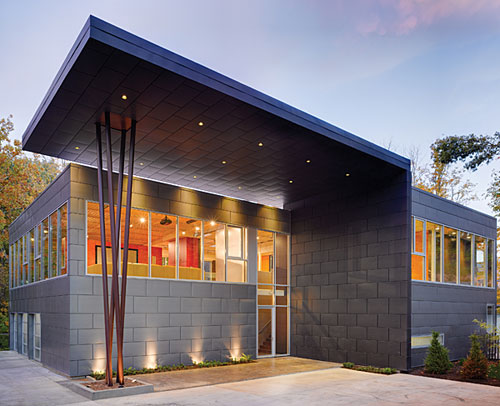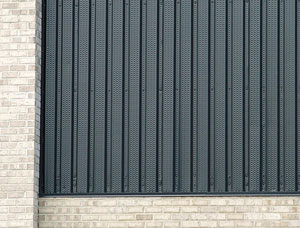Zinc: The Sustainable Choice among Architectural Metals
Zinc Wall Panel Applications
Metal wall and façade panels are often selected to create a durable exterior skin that contributes to an overall high quality building envelope. Accordingly, wall panel manufacturers have developed innovative systems which use all the material qualities of zinc described above plus they have developed a range of systems supplied with preformed finishing accessories produced specifically for covering facades, for both new construction and renovation. Several general types of wall panels include:
• Flat wall panels: The traditional standing seam system allows long strips of profiled zinc panels to be assembled by forming single folds on the upstands. The sheets are laid on continuous sheathing and anchored using fixing clips. This system, which can be installed either horizontally or vertically, provides maximum water and wind resistance and is generally found to be an easy and cost effective installation. Further, it can be integrated with roofing systems for visual continuity, installed on curved surfaces, and applied to new or renovation projects. Smaller sized panels are also available primarily for flat facades that simplify installation but have more visible seams which may be desirable only in certain designs.
• Rain screen panels: The growing popularity of using ventilated spaces behind cladding to create a rain screen over a sheathing barrier has prompted a variety of zinc panels that are very appropriate for both new and renovation projects. Many rain screen panels of this type are interlocking and fabricated as metal pans giving them great structural rigidity over long vertical and horizontal distances. Further, they can be designed and specified to be fully pressure equalized assuring the best ongoing performance over the life of the building. The panels are typically connected by the use of an interlocking groove giving the elegant appearance of a recessed joint. They are fixed onto a framework of either wood or metal as appropriate to the design using metal clips which are concealed in the inside edge of the groove. Many have the advantage of requiring no sealants, gaskets or butyl tape in the panel joints meaning no dirty streaks will be created from them and maintenance is notably reduced or eliminated. Further, since the zinc metal panels are not laminated nor a composite, they will never delaminate.
 |
Zinc wall panels installed as a rain screen with deep reveal joints. Photo: Dri-Design and VM Zinc, USA |
Â
• Decorative shingles: In some peaked roof applications, the gable end wall is enhanced by the use of decorative zinc shingles. These pre-formed, pieces are typically designed for overlapping, easy installation that produce very good weatherproofing on vertical wall surfaces and can be integrated with a full range of flashings for an all metal envelope where desired.
• Innovative solutions: An emerging wall system in industrial buildings is the use of metal wall panels to act as a solar air collector to condition the ventilation air in the building. Known as a transpired solar pre-heater, zinc wall panels can be used to heat make-up air for industrial buildings and provide a simple, economical approach to meet air quality standards. When properly designed and coordinated into the building, ventilation air is actively heated by solar energy, heat loss through the wall is recaptured, and stratified heat at the ceiling is utilized at the working level. The transpired solar wall heater is usually installed on the south-facing wall of a building, where air at the surface of the wall absorbs heat from the sun. Fan units or passive openings located at regular intervals along the wall near the roof draw the heated air through tiny perforations in the metal wall cladding. Each fan has modulating outside air and return dampers, discharge air temperature sensors and controls, and a duct that distributes the solar heated air along the ceiling of the plant through numerous openings. When make-up air is no longer required and the fan system is shut down, the outside air dampers close automatically. During summer months, when heating from the wall is not required, outside air is brought directly into the distribution ducts through by-pass dampers.
 |
|
Transpired solar collector used on an industrial building with perforated wall panels. Photos: ATAS Corporation |
 |
Â
Ventilation requirements for industrial facilities vary widely according to the type of processes taking place in the building. Air change rates of one half to four per hour are common. Heating these large volumes of air during cooler months can be expensive. Tests have shown that for this type of system, each square foot of transpired solar collector provides approximately 2 to 3 therms of energy annually. Further, in a typical industrial building with high ceilings, air within the space stratifies according to temperature such that all of the hot air can be up at the ceiling, leaving colder air at the lower levels where people are working. During cold weather, air distribution fans and ductwork from this system redirect the stratified heat trapped at the ceiling and carry the heat back down to the working level for the comfort of the employees. All of these benefits, based on free energy from the sun, translate to financial savings and an improved working environment.









